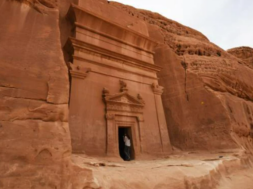
Roving Periscope: Opening up, Saudis look beyond oil, boost global tourism
Virendra Pandit
New Delhi: Deeply concerned that its black gold—petroleum—might vanish in thin air in the next couple of decades, Saudi Arabia has embarked on an ambitious program to become a global tourism hub to generate revenue, even if by relaxing some Islamic norms, and is working to make India one of its key tourism markets.
According to Saudi Tourism Board CEO Fahd Hamidaddin, the relaxations for foreign tourists include freedom from wearing an abaya (loose-fitting, full-length robe for women), and a waiver from producing marriage certificates for couples staying together, the media reported on Wednesday.
About attracting more Indian tourists, he said the two sides could sign some bilateral agreements this year. For the Muslim tourists, their pilgrimage, Umrah, might be made more accessible and affordable.
“There are people who come to Saudi historically, the Muslims. We are trying to make it a lot easier as far as access is concerned. The message is that we welcome everyone,” he added.
The appetite from Indians is very promising, Hamidaddin said.
In 2019, Saudi Arabia started opening up as a new tourist destination and launched a global marketing campaign to make it a leading revenue-earning sector. It offered e-visas to tourists from over 50 countries and allowed visas-on-arrival to those holding a valid US or UK visa.
Saudi Arabia has six UNESCO World Heritage sites and over 10,000 archaeological sites, including the Red Sea, home to coral reefs and huge biodiversity.
As part of its recent efforts to boost global tourism, Riyadh signed a deal with Emirates, a leading Dubai-based commercial career, to fast-track measures to streamline its air connectivity network.
“Saudi Arabia is undergoing a major transformation, which includes a pipeline of unique projects that will help position it as one of the world’s most attractive tourism destinations and help tell its story to the world,” Arab News reported.
The Saudi-Emirates MoU will enable the Saudis to reach over 120 destinations around the world to attract tourists to their own country.
A major boost to attract global tourists is part of the Vision 2030 reform agenda launched by Saudi Crown Prince Mohammed bin Salman in 2017 to diversify the Kingdom’s economy away from oil by bolstering a host of other industries, including tourism.
For centuries, most of Arabia’s revenues came from religious tourism. Almost 20 percent of the Kingdom’s GDP from non-oil sources in 2019 — nearly USD 12 billion — came from Hajj and Umrah pilgrims to the holy sites in Makkah and Madinah. The pandemic-related restrictions, however, slowed down this pilgrimage in the last two years.
By 2030, the Kingdom plans to make tourism contribute around 10 percent to its GDP, attract 100 million annual visits to its major attractions (45 million domestic travelers and 55 million inbound tourists), and create 1 million additional jobs, according to reports.
No other country is investing so much money now to showcase its tourist attractions to woo global travelers. The Saudis have partnered with tourism ministries in Southeast Asia, South Asia, and Europe, besides other regions, to promote this sector. They have also launched several projects across the country to provide the required accommodation, transport links, and other amenities.
Among the chief attractions for global tourists in Saudi Arabia are Al Ula, a region near Madinah in the northwest famous for its wonderful desert landscape and its historical, geographical, and geological significance since the pre-Islamic era. A ghost town until recently, it is one of the world’s largest open museums, with a 200,000-year history of human habitation.
The project to develop this site will run through 2035 and aims to create 38,000 new jobs. It might attract 2 million visitors a year, expand the area’s population to 130,000, and contribute USD 32 billion to the Kingdom’s economy. Over USD 2 billion have already been invested in the project, and USD 3.2 billion is being spent on priority infrastructure.
Besides, Saudi Arabia will also offer a new destination, Neom, the Kingdom’s first smart city taking shape on the Red Sea coast where 45,000 rooms will be available by 2030. By then, they will develop 22 islands with 48 resorts.
In 2021, the government announced plans to make Saudi Arabia a global transportation and logistics hub by 2030, targeting passenger traffic of 330 million per annum.













